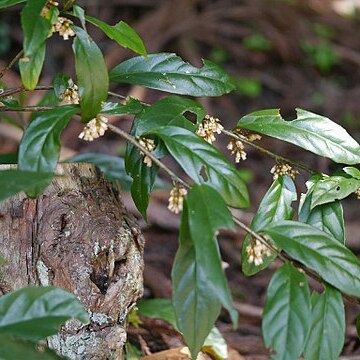Shrubs erect, sometimes decumbent or scandent, 1-3(-5) m tall. Branchlets terete, apex glandular granulose, early glabrescent; pith solid. Petiole canaliculate, 5-13 mm; leaf blade elliptic, lanceolate, to obovate, 5-16 × 2-5 cm, leathery, inconspicuously pellucid punctate, base cuneate or obtuse to rounded, smooth adaxially, margin entire toward base and subentire to serrate distally with mucronate teeth, apex acuminate to acute or obtuse; lateral veins 5-8 on each side of midrib. Inflorescences axillary, racemose or paniculate, 1-3(-4) cm, glabrous; bracteoles broadly ovate or reniform, to 1 mm, dark punctate-lineate, ciliate, encircling pedicel. Flowers white, 3.5-5 mm. Pedicel 2.5-3.5 mm, glandular granulose, glabrescent. Calyx ca. 2 mm; lobes ca. 1 mm, ovate to orbicular, punctate-lineate, margin entire, ciliate, apex obtuse or rounded. Corolla white, tubular-campanulate; tube 3-4 mm, prominently punctate-lineate; lobes reniform or ovate, ca. 1 mm, apex rounded or obtuse. Stamens included; anthers ovate, as long as filaments, glandular on back. Pistil included. Style slender, persistent, conical at base in fruit; stigma lobed. Fruit globose or ovoid, 4-5(-6) mm in diam., fleshy, punctate-lineate. Fl. Jan-Mar, fr. Oct-May.
More
A small shrub. It is evergreen and climbing. It grows 1-3 m high. The leaves are sword shaped. They are 5-16 cm long by 2-6 cm wide. They are leathery. There are teeth towards the end. The flowers are white. They are in groups 1-3 cm long in the axils of leaves. The fruit are round and turn from yellow to white. They are 4-4 mm across.

